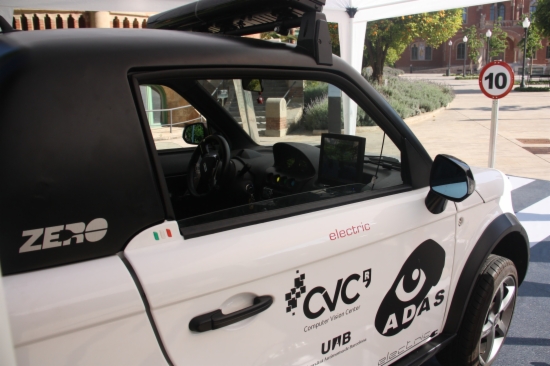Driverless electric car cheaper than Google's developed by Barcelona's Autònoma University
A team of researchers from the Universitat Autònoma de Barcelona (UAB) has developed an electric car that can move without a driver, identifying roads, obstacles and traffic signs with its cameras. In fact, the use of cameras instead of expensive sensors is the main difference from similar existing models and makes the Catalan car much cheaper than its potential competitors, such as Google's prototype. In addition, the use of less sophisticated devices, such as simple cameras, makes the UAB prototype demand more intelligent algorithms and programmes than its competitors, says Antonio López of UAB's Centre of Computer Vision. In the last few years, Catalonia, and particularly Barcelona and its Metropolitan Area, has become one of the main centres at world level developing electric vehicles. In addition, Barcelona is also a world reference point within the mobile industry, as well as the Internet of Things and smart cities industries, hosting the Mobile World Congress each year and many smart city projects.

Barcelona (ACN).- A team of researchers from the Universitat Autònoma de Barcelona (UAB) has developed an electric car that can move without a driver, identifying roads, obstacles and traffic signs with its cameras. In fact, the use of cameras instead of expensive sensors is the main difference from similar existing models and makes the Catalan car much cheaper than its potential competitors, such as Google's prototype. In addition, the use of less sophisticated devices, such as simple cameras, makes the UAB prototype demand more intelligent algorithms and programmes than its competitors, says Antonio López of UAB's Centre of Computer Vision. However, according to him, electric cars without drivers will not be a regular sight on the roads until at least 2025, although some of the technology they use can already be used. In the last few years, Catalonia, and particularly Barcelona and its Metropolitan Area, has become one of the main centres at world level developing electric vehicles. In addition, Barcelona is also a world reference point within the mobile industry, as well the Internet of Things and smart cities industries, hosting the Mobile World Congress each year and many smart city projects.
An electric car that would allow the user not to worry about driving because the car itself would be doing the driving was already possible in previous prototypes, but the vehicle developed by UAB researchers uses much cheaper technology, as Dr. Antonio López explains. "What we are trying to do is to focus on using sensors that are in some ways cheaper, such as cameras; this is the opposite of other projects, which are more expensive, such as the device called Velodyne that Google uses, which is located on top of the car and costs around $70,000", López told ACN on Thursday. "The cameras are much cheaper", he stressed.
"Of course this is a challenge, because what you lose in terms of the sophistication brought in by that hardware and those devices, you have to obtain through the development of more intelligent algorithms, a more intelligent software, more intelligent programmes", he added. The development of such complex algorithms and the technology associated with this car require inter-disciplinary work, mixing different scientific areas, López pointed out.
A sophisticated computer set up in the car's trunk works as the vehicle's driver thanks to the information it gets through cameras that have been installed on top of the car. This type of car will not be on the road until 2025 at the earliest but its development is a great technological "challenge", stressed López, and allows the launching of new technologies and applications that can be already used today in other projects.
According to the UAB researcher, the development of the electric car that drives itself "is a long-term project, but we expect that the technologies we are developing over the course of our daily work may be useful for the applications of today, particularly some of the things such as detecting pedestrians, vehicles, lane markings, roads, traffic signs..." Indeed, some of these technologies could already be used in today’s cars; "they are systems that can be already used to help drivers", López highlighted.
One of these technologies is the control of the car's front lights. In the UAB car prototype, the user will not be driving and therefore he or she would not be controlling the front lights. Instead, a sensor measures the need for extra light and regulates the device accordingly. This technology could already be used in today’s cars, helping the driver by allowing him to not worry about this aspect of driving any longer. Another example is the detection of pedestrians on the road. The system would prevent the car from running over somebody in case the driver has not seen the person or cannot react on time.
The UAB project has been carried out by a team formed by 2 people working full-time and the work of 15 other contributors. The project received public funding but needed further funds to carry on. López explained how they obtained some of this funding by investing profits obtained through other minor projects in private companies. He also highlighted the difficulties to combine such a demanding research project with the work of university teaching, a combination that requires a great deal of "commitment". However, according to him, research and innovation are the way to go, making them become "the engine of the economy".